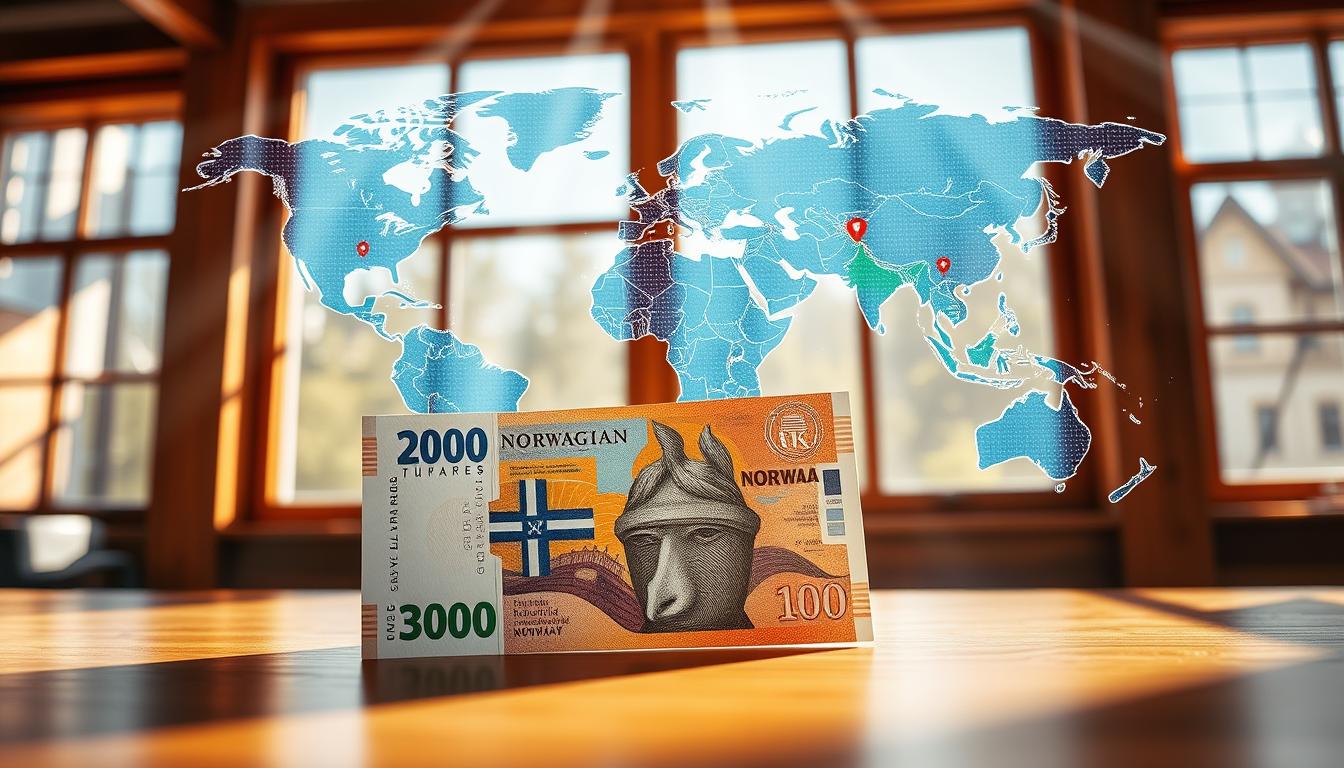✓ Accommodations✓ Flights✓ Rental Cars✓ Tours & Activities
Did you know that over 90% of transactions in Norway are made using cards? This makes it one of the most cashless societies in the world. If you’re planning a trip to this breathtaking country, understanding its currency and payment systems is essential for a smooth experience.
Norway uses the Norwegian krone (NOK), not the Euro. Knowing the current exchange rate can save you from unexpected costs. Using your card wisely is key, as ATMs are widely available, and most places accept card payments.
Planning ahead ensures you avoid high fees and enjoy your trip without financial stress. This guide will cover everything from currency exchange tips to budgeting and tipping. Let’s make your journey hassle-free!
Understanding Norway’s Monetary System
Exploring Norway’s monetary system can make your trip smoother. The country uses the Norwegian krone (NOK), a currency with a rich history and modern practicality. Understanding how it works can help you navigate payments effortlessly during your stay.
Overview of the Norwegian Krone
The Norwegian krone, often called the “crown,” has been the official currency since 1875. It replaced the speciedaler, marking a significant shift in the country’s financial system. Today, the krone is divided into 100 øre, though øre coins are no longer in physical circulation.
Banknotes come in denominations of 50, 100, 200, 500, and 1,000 kroner. Coins are available in 1, 5, 10, and 20 kroner. While cash is still accepted, most transactions are digital, making cards and mobile payments the norm.
History and Local Significance
The krone’s history dates back to the Scandinavian Monetary Union, which included Sweden and Denmark. After the union dissolved in 1914, Norway retained the krone, which has since become a symbol of national identity.
Today, the krone is known for its stability, making it a reliable choice for travelers. Its value is closely tied to Norway’s oil revenues, which influence exchange rates. This stability ensures that your money retains its value during your trip.
Here’s a quick comparison of cash and card usage in urban and rural areas:
| Location | Cash Usage | Card Usage |
|---|---|---|
| Urban Areas | Rare | Widespread |
| Rural Areas | Occasional | Common |
In cities, you’ll find that debit cards are accepted almost everywhere. In rural areas, while cards are still widely used, it’s a good idea to carry some cash for smaller vendors or remote locations. Understanding this balance ensures you’re prepared for any situation.
Essential Currency Exchange Tips for Your Trip
Currency exchange doesn’t have to be complicated with the right tips. Whether you’re planning to use cash or rely on cards, understanding the process can save you time and money. Here’s how to make the most of your exchange experience.
When and Where to Exchange Your Money
Timing and location are key to getting the best rates. Avoid exchanging currency at airports or hotels, as they often charge higher fees. Instead, head to city centers where banks and reliable exchange providers offer competitive rates.
Check the live exchange rate before your trip. This ensures you know the current value of your currency. For example, 1 USD equals approximately 10.86 NOK. A little research can save you from unnecessary markups.
Comparing Rates and Avoiding Markups
Not all exchange services are created equal. Compare rates from multiple providers to find the best deal. Look for hidden fees, which can add up quickly. Using a travel debit card with real-time conversion at mid-market rates is a smart alternative.
Here’s a quick comparison of exchange options:
| Option | Pros | Cons |
|---|---|---|
| Banks | Reliable, competitive rates | May require account access |
| Exchange Providers | Convenient, multiple locations | Higher fees in tourist areas |
| Travel Debit Cards | Real-time rates, low fees | Limited to card transactions |
By planning ahead, you can avoid unnecessary costs and focus on enjoying your trip. Whether you choose cash or cards, these tips will help you manage your money efficiently.
Using Credit and Debit Cards in Norway
Using credit and debit cards in Norway is seamless and hassle-free. Most places, including hotels, shops, and restaurants, accept cards. This makes it easy to manage your costs without carrying cash.
Where Cards Are Widely Accepted
Visa and Mastercard are the most commonly accepted credit cards. You’ll find them usable in cities and even smaller towns. From grocery stores to public transport, cards are the preferred payment method.
However, some remote areas or small vendors may prefer cash. It’s a good idea to carry a small amount of NOK for such situations. This ensures you’re prepared for any scenario.
Card Use in Rural vs. Urban Areas
In urban areas, card payments are the norm. You’ll rarely need cash for daily transactions. In rural regions, while cards are still widely accepted, having some cash can be helpful for smaller purchases.
Here’s a quick comparison of card usage:
- Urban Areas: Nearly all businesses accept cards.
- Rural Areas: Cards are common, but cash is useful for small vendors.
Using a travel card can help you avoid extra bank fees. These cards often offer real-time exchange rates, saving you money on conversions. Always check with your bank about international transaction fees before your trip.
Safety is also important. Notify your bank of your travel plans to avoid card blocks. Opt for charges in NOK to avoid unfavorable exchange rates. These small steps ensure a smooth and secure payment experience.
Navigating Cash Withdrawals and ATMs
Managing cash withdrawals during your trip can be straightforward with the right approach. Norway has a reliable network of ATMs, making it easy to access local currency. Whether you’re in a bustling city or a quiet village, knowing where and how to withdraw cash ensures you’re always prepared.

Finding Reliable ATM Locations
In urban areas, ATMs are plentiful and often located near banks, shopping centers, and transport hubs. Rural regions may have fewer options, but most towns still offer access. Use apps or maps to locate ATMs in advance, especially if you’re heading to remote areas.
Travel debit cards, like those from Wise, are a great option. They allow you to withdraw local currency at competitive exchange rates. Always check for ATMs that display major card payment logos to ensure compatibility.
Timing Your Withdrawals
Timing can impact your service experience. Avoid peak hours when ATMs might be busy or low on cash. Early mornings or late evenings are often quieter. This also helps you avoid unnecessary delays.
Some ATMs charge fees, especially in tourist-heavy areas. Withdraw larger amounts less frequently to minimize transaction costs. Always check your bank’s international withdrawal fees before traveling.
Safeguarding Your Funds
Safety is crucial when using ATMs abroad. Choose machines in well-lit, secure locations. Shield your PIN and avoid using ATMs that look tampered with. Notify your bank of your travel plans to prevent card blocks.
Here’s a quick comparison of ATM withdrawal options:
| Option | Pros | Cons |
|---|---|---|
| Bank ATMs | Reliable, low fees | May require account access |
| Independent ATMs | Convenient, multiple locations | Higher fees in tourist areas |
| Travel Debit Cards | Real-time rates, low fees | Limited to card transactions |
By following these tips, you can ensure a smooth and cost-effective cash withdrawal process. Whether you’re exploring cities or rural areas, being prepared saves you time and money.
Comparing Exchange Rates and Avoiding Extra Fees
Getting the best deal on currency exchange starts with knowing the rates. Whether you’re planning from home or already abroad, understanding how much your money is worth in currency Norway can save you from unnecessary costs.
For example, 1 Euro equals around 11.80 NOK, while 1 USD is approximately 10.96 NOK. Similarly, 1 AUD converts to about 6.88 NOK. These rates can fluctuate, so checking real-time updates before exchanging is essential.
USD, Euro, and AUD Conversion Insights
When converting USD, Euro, or AUD to NOK, you’ll find that rates vary depending on the provider. Banks often offer better rates than airports or tourist areas, where markups can be as high as 20%. For instance, a meal at a restaurant costing 200 NOK would be around $18.25 USD or €16.95.
Here’s a quick comparison of current rates:
- 1 USD = 10.96 NOK
- 1 Euro = 11.80 NOK
- 1 AUD = 6.88 NOK
To avoid extra fees, steer clear of exchanges in high-traffic areas like airports. Instead, use trusted online platforms or local banks. Even small fees can add up, so planning ahead ensures your travel budget stays intact.
For up-to-date rates, websites like Wise and XE are reliable resources. They provide real-time conversions without hidden charges. By staying informed, you’ll make the most of your money and enjoy your trip without financial stress.
Budgeting and Average Costs in Norway
Planning your budget for a trip to Norway can make your experience smoother and more enjoyable. Knowing the average costs for dining, transportation, and activities helps you prepare financially. This way, you can focus on exploring without worrying about overspending.

Daily Expenses and Dining Costs
Daily expenses in Norway can vary depending on your travel style. For budget travelers, a day might cost around $68 (NOK 467), while mid-range travelers could spend $161 (NOK 1,107). Luxury travelers might budget $394 (NOK 2,713) daily.
Dining out is a highlight of any trip. A meal at an inexpensive restaurant costs around 200 NOK, while a three-course meal at a mid-range restaurant can set you back 700 NOK. Here’s a quick breakdown of common food and drink prices:
- Bottle of water (330 ml): 27 NOK
- Domestic beer: 44 NOK
- Cappuccino: 49 NOK
- Street food meal: 70 NOK
To save on dining, consider self-catering or enjoying hotel breakfasts included in your stay. This can significantly reduce your daily food expenses.
Transportation and Activity Pricing
Getting around is efficient but can add up. A train ticket from Oslo to Bergen costs 300 NOK, while a Flåm railway round-trip is 500 NOK. Public transport in cities is affordable, with daily passes around 100 NOK.
Activities are a key part of your trip. Entry to popular attractions like the Viking Ship Museum costs 100 NOK, while a fjord tour might be 360 NOK. For unique experiences, a Northern Lights cruise can cost 2,440 NOK.
Here’s a comparison of average costs for different travel styles:
| Category | Budget | Mid-Range | Luxury |
|---|---|---|---|
| Accommodation (per night) | 217 NOK | 564 NOK | 1,411 NOK |
| Meals (per day) | 119 NOK | 304 NOK | 716 NOK |
| Activities (per day) | 152 NOK | 300 NOK | 700 NOK |
By planning ahead and using a card norway for most transactions, you can manage your expenses effectively. Always check currency exchange rates to avoid unnecessary fees. With these tips, you’ll need less stress and more time to enjoy your trip.
Tipping and Additional Payment Insights
Understanding tipping customs can make your trip more enjoyable and stress-free. In many places, tipping is optional, but knowing the norms ensures you navigate payments smoothly. This guide will help you understand when and how to tip, so you can focus on enjoying your experience.
Local Tipping Customs
Tipping in Norway is not as common as in some other countries. In most places, service charges are included in the bill, so tipping is optional. However, in bars and restaurants, a tip of 5% to 15% is appreciated for exceptional service. This is a great way to show your appreciation.
For example, if your meal costs 500 NOK, leaving an additional 50 NOK (10%) is a thoughtful gesture. In taxis or for hotel staff, rounding up the bill is sufficient. This option is simple and ensures you’re not overspending.
When to Tip and How Much
Here’s a quick breakdown of when tipping is advisable:
- Restaurants and Bars: 5% to 15% for excellent service.
- Taxis: Round up to the nearest 10 or 20 NOK.
- Hotel Staff: 10 to 20 NOK for porters or housekeeping.
Always check your bill to make sure a service charge isn’t already included. This way, you avoid tipping twice. For U.S. visitors, remember that tipping is less frequent here than back home, so adjust your expectations accordingly.
Alternative Payment Insights
Many restaurants and hotels include service charges in the bill. This means you don’t need to tip unless you feel the service was exceptional. Using a card for payments is the norm, and most places accept Visa and Mastercard. This is a convenient way to manage your expenses without carrying cash.
Here’s a comparison of tipping practices in different scenarios:
| Scenario | Tipping Norm |
|---|---|
| Restaurants | 5% to 15% |
| Taxis | Round up |
| Hotel Staff | 10 to 20 NOK |
By following these tips, you’ll navigate tipping and payments with ease. Being informed enhances your travel experience and ensures you’re prepared for any situation.
Protecting Your Money: Fees and Safety Measures
Keeping your money safe while traveling is crucial for a stress-free experience. From avoiding scams to managing fees, a little preparation goes a long way. Here’s how to protect your finances and make the most of your trip.

Avoiding Airport Exchange Scams
Airport exchanges often charge higher fees and offer poor rates. Instead, use local banks or trusted exchange providers in the city. This ensures you get a fair price for your currency.
Always check the current exchange rate before converting money. For example, 1 AUD equals approximately 6.88 NOK. Knowing this helps you avoid unnecessary charges.
Using Travel Debit Cards for Cost-Effective Payments
Travel debit cards, like Wise, are a smart choice. They offer real-time exchange rates and low fees. This makes them ideal for managing transactions without extra charges.
Here’s why travel cards are beneficial:
- No hidden fees for international transactions.
- Easy to track spending in your home currency.
- Accepted at most ATMs and businesses.
Notify your bank of your travel plans to avoid card blocks. This simple tip ensures uninterrupted access to your funds.
Practical Tips for Safeguarding Your Money
Carry a mix of cash and cards for flexibility. Avoid carrying more than 25,000 NOK to comply with local regulations. This reduces the risk of loss or theft.
Monitor your accounts regularly for unauthorized transactions. This is a key tip for staying secure while abroad.
By following these steps, you can protect your money and focus on enjoying your trip. Being prepared saves you time, stress, and unnecessary expenses.
Planning Payment Options: Norway: Ultimate Travelers Guide to Currencies & Payments
Planning your payment options before your trip ensures a smooth experience. In Norway, the official currency is the Norwegian krone (NOK), and understanding how to manage your money is essential. Whether you prefer cards, cash, or a mix of both, being prepared saves you time and stress.
Cards are widely accepted in most places, from restaurants to shops. Visa and Mastercard are the most common, and using them is convenient. However, carrying some cash is still a good idea, especially in rural areas or for smaller vendors. This flexibility ensures you’re never caught off guard.
When exchanging money, avoid airports and hotels, as they often charge higher fees. Instead, compare rates at local banks or trusted exchange providers. Checking the market rate before your trip helps you get the best deal. For example, 1 USD equals approximately 10.96 NOK.
Here’s a quick comparison of exchange options:
| Option | Pros | Cons |
|---|---|---|
| Local Banks | Reliable, competitive rates | May require account access |
| Exchange Providers | Convenient, multiple locations | Higher fees in tourist areas |
| Travel Debit Cards | Real-time rates, low fees | Limited to card transactions |
Travel debit cards, like Wise, are a smart choice. They offer real-time exchange rates and low fees, making them ideal for managing transactions. Notify your bank of your travel plans to avoid card blocks. This simple step ensures uninterrupted access to your funds.
Having multiple payment methods is key. While cards are convenient, cash is useful for smaller purchases or in areas with limited card acceptance. By planning ahead, you can avoid disruptions and focus on enjoying your trip.
Finally, always review reliable exchange data before making conversions. Websites like Wise and XE provide up-to-date rates without hidden charges. With these tips, you’ll manage your finances efficiently and make the most of your journey.
Money-Saving Tips for Your Norwegian Vacation
Saving money during your trip doesn’t have to be a challenge with the right strategies. From choosing budget-friendly hotels to leveraging prepaid cards, these tips will help you make the most of your travel money.

Strategies for Budget Travelers
Start by researching affordable accommodation. Budget-friendly hotels and hostels in the city center can save you significant amounts. For example, dorm rooms in Oslo cost around $60 per day, while private rooms in Tromso average $97 during peak season.
Plan your meals wisely. Opt for self-catering or enjoy daily specials at local eateries. A meal at a mid-range restaurant costs $25-$30, but street food or grocery stores can cut this expense in half.
Use public transportation to save on travel money. Daily passes in cities like Oslo cost around $13, while airport express trains are $22. Booking train tickets in advance can also secure lower prices.
Leveraging Prepaid and Travel Cards
Prepaid and travel debit cards are excellent tools for managing expenses. They offer real-time exchange rates and low fees, making them ideal for international travel. Apps like Wise or Revolut help you monitor transactions and avoid hidden charges.
Here’s why these cards are beneficial:
- No hidden fees for international transactions.
- Easy to track spending in your home currency.
- Accepted at most ATMs and businesses.
In case of emergencies, having a prepaid card ensures you’re never without funds. Notify your bank of your travel plans to avoid card blocks and ensure uninterrupted access to your money.
By combining these strategies, you can reduce your travel money expenses and focus on enjoying your trip. Intelligent planning and the right tools make budget travel both achievable and enjoyable.
Conclusion
Planning your finances for a trip ensures a stress-free experience. By understanding local payment methods, you can avoid unnecessary fees and make the most of your budget. Whether using a credit debit card or withdrawing cash from an atm, being prepared saves time and money.
Always check transaction details and withdrawal limits before traveling. Notify your account provider to avoid disruptions. Using travel cards with low fees and real-time exchange rates is a smart way to manage expenses.
Careful planning enhances your overall journey. Stay informed, protect your funds, and enjoy every moment of your adventure. For more tips, revisit this guide and update your payment methods regularly. Safe travels!
The above is subject to change.
Check back often to TRAVEL.COM for the latest travel tips and deals.






